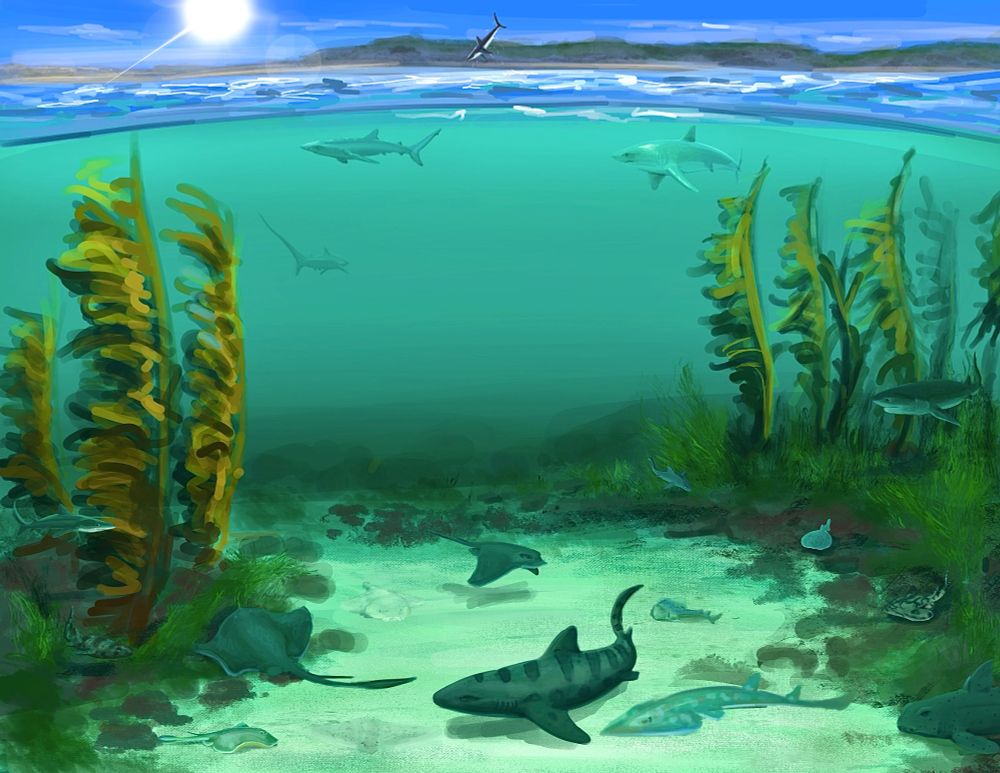
Twitter/Instagram: CJSeaArt
The cast of sharks and rays in the Marine Protected Areas of southern California hold a special place in my heart and to celebrate my last year of university here I spent weeks on this mural (inspired by Joschua Knuppe) of the native species I've come to love!

The cast of sharks and rays in the Marine Protected Areas of southern California hold a special place in my heart and to celebrate my last year of university here I spent weeks on this mural (inspired by Joschua Knuppe) of the native species I've come to love!
Despite appearing like a generic ray, Dasmyliobatis represents an intermediary state between the eagle rays and whiptail rays (or what many consider stingrays). The holotype was discovered in Italian rocks dating to the Eocene.

Despite appearing like a generic ray, Dasmyliobatis represents an intermediary state between the eagle rays and whiptail rays (or what many consider stingrays). The holotype was discovered in Italian rocks dating to the Eocene.
Named after its teeth that resemble the spaceships in Galaga, this holotype of this freshwater carpet shark was famously discovered near the remains of Sue the T.rex. Unlike the giant dinosaur, Galagadon only was about a foot or so long.

Named after its teeth that resemble the spaceships in Galaga, this holotype of this freshwater carpet shark was famously discovered near the remains of Sue the T.rex. Unlike the giant dinosaur, Galagadon only was about a foot or so long.
An extinct relative of modern frilled sharks, R.goliath was discovered to be from the Late Cretaceous of Angola, and lives up to its species name: potentially growing up to 6 meters (or almost 20 feet) long!

An extinct relative of modern frilled sharks, R.goliath was discovered to be from the Late Cretaceous of Angola, and lives up to its species name: potentially growing up to 6 meters (or almost 20 feet) long!
Despite looking like it has two mouths, the upper appendage of this Jurassic chimaera relative is likely a head clasper, which is used in holding onto females during reproduction, supported with en elongated cartilaginous rostrum!

Despite looking like it has two mouths, the upper appendage of this Jurassic chimaera relative is likely a head clasper, which is used in holding onto females during reproduction, supported with en elongated cartilaginous rostrum!
This strange animal superficially resembles flying fish, but is actually more related to the modern day chimaera. Found in warm shallow Carboniferous seas, this fish grew just over a foot long, and used its large pectoral fins for locomotion.

This strange animal superficially resembles flying fish, but is actually more related to the modern day chimaera. Found in warm shallow Carboniferous seas, this fish grew just over a foot long, and used its large pectoral fins for locomotion.
Part of the acanthodiians, or "spiny sharks", this Permian fish is believed to provide insight into the common ancestors of both cartilaginous and bony fish. Acanthodes was found to be toothless and thus could have been a suspension feeder!

Part of the acanthodiians, or "spiny sharks", this Permian fish is believed to provide insight into the common ancestors of both cartilaginous and bony fish. Acanthodes was found to be toothless and thus could have been a suspension feeder!

















palaeo-electronica.org/content/2025...

palaeo-electronica.org/content/2025...



